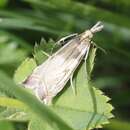en
names in breadcrumbs


Crambus pratella is a species of moth of the family Crambidae. It is found in Europe and Asia Minor.
The wingspan is 22–25 mm. Forewings with apex somewhat produced; brown, sometimes ochreous-mixed, in male with grey, in female with whitish blackish-edged interneural streaks; a subcostal white streak on basal half; a white median streak, upper edge straight, lower edge projecting in middle, cut by sharply angulated dark brown median line; second line angulated, white, edged with dark brown, preceded by white costal mark; a white terminal streak, with several black dots; cilia metallic. Hindwings are rather dark grey [applies partly to Crambus pascuella but this is smaller and has a narrower longitudinal streak]. The larva is greenish-grey or brownish-grey; dots darker; head brown, darker-marked.[1]
The moth flies from May to August depending on the location.
The larvae feed on various grasses, especially Deschampsia species.
Crambus pratella is a species of moth of the family Crambidae. It is found in Europe and Asia Minor.
 Fig. 3 larva after final moult
Fig. 3 larva after final moult The wingspan is 22–25 mm. Forewings with apex somewhat produced; brown, sometimes ochreous-mixed, in male with grey, in female with whitish blackish-edged interneural streaks; a subcostal white streak on basal half; a white median streak, upper edge straight, lower edge projecting in middle, cut by sharply angulated dark brown median line; second line angulated, white, edged with dark brown, preceded by white costal mark; a white terminal streak, with several black dots; cilia metallic. Hindwings are rather dark grey [applies partly to Crambus pascuella but this is smaller and has a narrower longitudinal streak]. The larva is greenish-grey or brownish-grey; dots darker; head brown, darker-marked.
The moth flies from May to August depending on the location.
The larvae feed on various grasses, especially Deschampsia species.